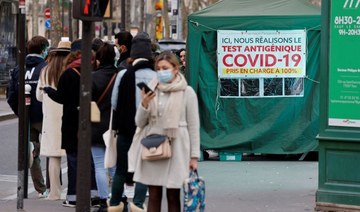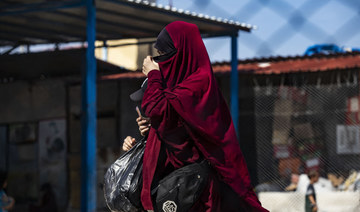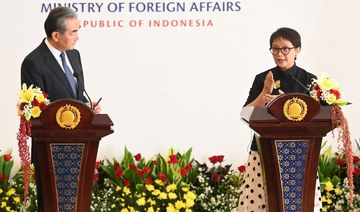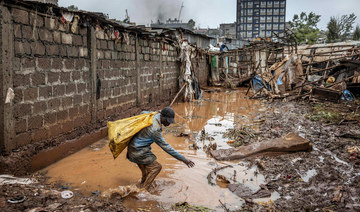ROME: To mask or not to mask is a question Italy settled early in the COVID-19 outbreak with a vigorous “yes.” Now the onetime epicenter of the pandemic in Europe hopes even stricter mask rules will help it beat the latest infection surge.
Other countries are taking similar action as the more transmissible — yet, apparently, less virulent — omicron variant spreads through the continent.
With Italy’s hospital ICUs rapidly filling with mostly unvaccinated COVID-19 patients, the government announced on Christmas Eve that FFP2 masks — which offer users more protection than cloth or surgical masks — must be worn on public transport, including planes, trains, ferries and subways.
That’s even though all passengers in Italy, as of this week, must be vaccinated or recently recovered from COVID-19. FFP2s also must now be worn at theaters, cinemas and sports events, indoors or out, and can’t be removed even for their wearers to eat or drink.
Italy re-introduced an outdoor mask mandate. It had never lifted its indoor mandate — even when infections sharply dropped in the summer.
On a chilly morning in Rome this week, Lillo D’Amico, 84, sported a wool cap and white FFP2 as he bought a newspaper at his neighborhood newsstand.
“(Masks) cost little money, they cost you a small sacrifice,” he said. “When you do the math, it costs far less than hospitalization.”
When he sees someone from the unmasked minority walking by, he keeps a distance. “They see (masks) as an affront to their freedom,’’ D’Amico said, shrugging.
Spain reinstated its outdoor mask rule on Christmas Eve. After the 14-day contagion rate soared to 2,722 new infections per 100,000 people by the end of last week — from 40 per 100,000 in mid-October — Prime Minister Pedro Sanchez was asked whether the outdoor mask mandate was helping.
“Of course, it is. It’s not me saying it. It’s science itself saying it because (it’s) a virus that is contracted when one exhales,’’ Sanchez said.
Portugal brought masks back at the end of November, after having largely dropped the requirement when it hit its goal of vaccinating 86 percent of the population.
Greece has also restored its outdoor mask mandate, while requiring an FFP2 or double surgical mask on public transport and in indoor public spaces.
This week the Dutch government’s outbreak management team recommended a mask mandate for people over 13 in busy public indoor areas such as restaurants, museums and theaters, and for spectators at indoor sports events. Those places are currently closed under a lockdown until at least Friday, Jan. 14.
In France, the outdoor mask mandate was partially re-instated in December in many cities, including Paris. The age for children to start wearing masks in public places was lowered to 6 from 11.
Austrian Chancellor Karl Nehammer announced last week that people must wear FFP2 masks outdoors if they can’t keep at least two meters (6.5 feet) apart.
In Italy, with more than 2 million people currently positive for the virus in a nation of 60 million and workplace absences curtailing train and bus runs, the government also sees masks as a way to let society more fully function.
People with booster shots or recent second vaccine doses can now avoid quarantine after coming into contact with an infected person if they wear a FFP2 mask for 10 days.
The government has ordered shops to make FFP masks available for 75 euro cents (85 US cents). In the pandemic’s first year, FFP2s cost up to 10 euros ($11.50) — whenever they could be found.
Italians wear them in a palette of colors. The father of a baby baptized this week by Pope Francis in the Sistine Chapel wore one in burgundy, with matching tie and jacket pocket square. But the pontiff, who has practically shunned a mask in public, was mask-less.
On Monday, Vatican City State mandated FFP2s in all indoor places. The tiny, walled independent state across the Tiber from the heart of Rome also stipulated that Vatican employees can go to work without quarantining after coming into contact with someone testing positive if, in addition to being fully vaccinated or having received a booster shot, they wear FFP2s.
Francis did appear to be wearing a FFP2 when, startling shoppers in Rome on Tuesday evening, he emerged from a music store near the Pantheon before being driven back to the Vatican.
In Britain, where Prime Minister Boris Johnson has focused on vaccination, masks have never been required outdoors.
This month, though, the government said secondary school students should wear face coverings in class. But Education Secretary Nadhim Zahawi said that rule wouldn’t apply “for a day longer than necessary.”
When the British government lifted pandemic restrictions in July 2021, turning mask-wearing from a requirement to a suggestion, mask use fell markedly.
Nino Cartabellotta, president of the Bologna-based GIMBE foundation, which monitors health care in Italy, says Britain points to what can happen when measures like mask-wearing aren’t valued.
“The situation in the U.K, showed that use of vaccination alone wasn’t enough” to get ahead of the pandemic, even though Britain was one of the first countries to begin vaccination, he said in a video interview.
Masks rules get tighter in Europe in winter’s COVID-19 wave
https://arab.news/2ru2g
Masks rules get tighter in Europe in winter’s COVID-19 wave
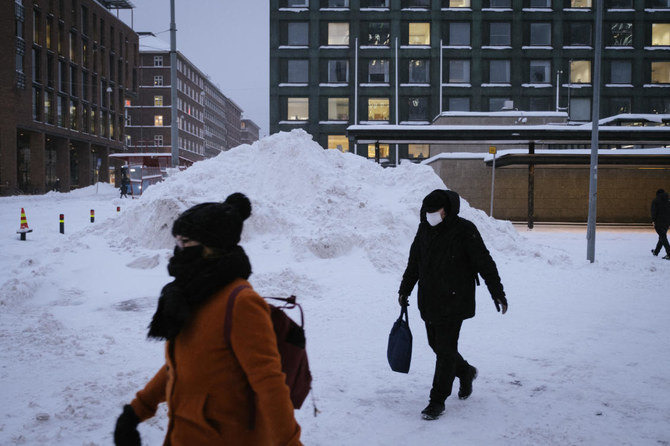
- Italy re-introduced an outdoor mask mandate
- Spain reinstated its outdoor mask rule on Christmas Eve
Pet dogs and strays suffer in Asia heatwave

- Increasing number of animals suffer nosebleeds, severe skin rashes in Kolkata in heatwave
- Experts say climate change makes heatwaves more frequent, longer and more intense
Kolkata: Soaring temperatures across Kolkata have brought life in much of the Indian megacity to a standstill, but veterinarian Partha Das cannot recall a time when he was more busy.
His clinic has been swamped by distressed members of the public carrying in beloved pets suffering nosebleeds, severe skin rashes and lapses into unconsciousness in a relentless heatwave suffocating much of South and Southeastern Asia over the past week.
“Many pets are also hospitalized for three or four consecutive days, and they are taking a long time to get back to normal,” the 57-year-old told AFP from his surgery.
“We are getting several heatstroke cases in a day. It’s unprecedented.”
Kolkata has sweltered through days of punishing heat, peaking at 43 degrees Celsius for the hottest single April day since 1954, according to the city’s weather bureau.
Streets of the normally bustling colonial-era capital have been almost deserted in the afternoons as its 15 million people do what they can to stay out of the sun.
But even cats and dogs lucky enough to have an owner have been susceptible to falling ill, with Das saying the heat had triggered a surge in dehydration-related illnesses in pets from around the city.
Teacher Sriparna Bose said her two cats had become sullen and withdrawn in a way she hadn’t seen before when the heatwave hit.
“They are refusing food,” she said. “They hide in dark, cold corners of the room and won’t come out.”
The situation is worse for the 70,000 stray dogs estimated to live on city streets by municipal authorities, which have no owner but are often fed and tended to by nearby residents.
Many are spending the day taking refuge from the sun under parked cars, while a lucky few are hosed down by sympathetic humans to help them cool off.
“They are finding it difficult to stand on their soft paws because the roads are so hot,” said Gurshaan Kohli of Humanimal Foundation, a local animal welfare charity for stray animals.
“Scores of dogs and cats have died” even though he and his colleagues had rushed them to clinics for treatment, he added.
Large swathes of South and Southeast Asia are struggling through a heatwave that has broken temperature records and forced millions of children to stay home as schools close across the region.
Experts say climate change makes heatwaves more frequent, longer and more intense, while the El Nino phenomenon is also driving this year’s exceptionally warm weather.
The heat has taken its toll on animals across the continent.
“They are eating less, and they are reluctant to move,” Henna Pekko of Rescue PAWS, which operates an animal shelter near Thailand’s capital Bangkok, told AFP.
With temperatures in Thailand exceeding 40 degrees Celsius over the past week, Pekko said her charity had taken to bringing its rescues to the ocean to cool down with a swim, while older dogs were being kept indoors.
“We are definitely taking extra precautions because of this weather,” she told AFP, adding that the stress on animals from the heat was the worst she had experienced in the kingdom.
“Last year was bad. This year was worse.”
Minnesota man who regrets joining Daesh group faces sentencing on terrorism charge

- Federal prosecutors have recommended 12 years for Abelhamid Al-Madioum in recognition both of the seriousness of his crime and the help has he given the US
- Al-Madioum was 18 in 2014 when Daesh recruited him
MINNEAPOLIS, USA: A Minnesota man who once fought for the Daesh group in Syria but now expresses remorse for joining a “death cult” and has been cooperating with federal authorities will learn Wednesday how much prison time he faces.
Federal prosecutors have recommended 12 years for Abelhamid Al-Madioum in recognition both of the seriousness of his crime and the help has he given the US and other governments. His attorney says seven years is enough and that Al-Madioum, 27, stopped believing in the group’s extremist ideology years ago.
Al-Madioum was 18 in 2014 when Daesh recruited him. The college student slipped away from his family on a visit to their native Morocco in 2015. Making his way to Syria, he became a soldier for Daesh, until he was maimed in an explosion in Iraq. Unable to fight, he used his computer skills to serve the group. He surrendered to US-backed rebels in 2019 and was imprisoned under harsh conditions.
Al-Madioum returned to the US in 2020 and pleaded guilty in 2021 to providing material support to a designated terrorist organization. According to court filings, he has been cooperating with US authorities and allied governments. The defense says he hopes to work in future counterterrorism and deradicalization efforts.
“The person who left was young, ignorant, and misguided,” Al-Madioum said in a letter to US District Judge Ann Montgomery, who will sentence him.
“I’ve been changed by life experience: by the treachery I endured as a member of Daesh, by becoming a father of four, a husband, an amputee, a prisoner of war, a malnourished supplicant, by seeing the pain and anguish and gnashing of teeth that terrorism causes, the humiliation, the tears, the shame,” he added. “I joined a death cult, and it was the biggest mistake of my life.”
Prosecutors acknowledge that Al-Madioum has provided useful assistance to US authorities in several national security investigations and prosecutions, that he accepted responsibility for his crime and pleaded guilty promptly on his return to the US But they say they factored his cooperation into their recommended sentence of 12 years instead of the statutory maximum of 20 years.
“The defendant did much more than harbor extremist beliefs,” prosecutors wrote in a sentencing memo. “He chose violent action by taking up arms for Daesh.”
A naturalized US citizen, Al-Madioum was among several Minnesotans suspected of leaving the US to join the Daesh group, along with thousands of fighters from other countries worldwide. Roughly three dozen people are known to have left Minnesota to join militant groups in Somalia or Syria. In 2016, nine Minnesota men were sentenced on federal charges of conspiring to join Daesh.
But Al-Madioum is one of the relatively few Americans who’ve been brought back to the US who actually fought for the group. According to a defense sentencing memo, he’s one of 11 adults as of 2023 to be formally repatriated to the US from the conflict in Syria and Iraq to face charges for terrorist-related crimes and alleged affiliations with Daesh. Others received sentences ranging from four years to life plus 70 years.
Al-Madioum grew up in the Minneapolis suburb of St. Louis Park in a loving and nonreligious family, the defense memo said. He joined Daesh because he wanted to help Muslims who he believed were being slaughtered by Syrian President Bashar Assad’s regime in that country’s civil war. Daesh recruiters persuaded him “to test his faith and become a real Muslim.”
But he was a fighter for less than two months before he lost his right arm below the elbow in the explosion that also left him with two badly broken legs and other severe injuries. He may still require amputation of one leg, the defense says.
While recuperating in 2016, he met his first wife Fatima, an Daesh widow who already had a son and bore him another in 2017. They lived in poverty and under constant airstrikes. He was unable to work, and his stipend from Daesh stopped in 2018. They lived in a makeshift tent, the defense says.
He married his second wife, Fozia, in 2018. She also was a Daesh widow and already had a 4-year-old daughter. They had separated by early 2019. He heard later she and their daughter together had died. The first wife also is dead, having been shot in front of Al-Madioum by either rebel forces or an Daesh fighter in 2019, the defense says.
The day after that shooting, he walked with his sons and surrendered to the Kurdish-led Syrian Democratic Forces, which held him under conditions the defense described as “heinous” for 18 months until the FBI returned him to the US
As for Al-Madioum’s children, the defense memo said they were eventually found in a Syrian orphanage and his parents will be their foster parents when they arrive in the US.
Polish officials condemn arson attack on Warsaw synagogue

- Foreign Minister Radoslaw Sikorski, quoting the country’s chief rabbi, said “someone tried to set fire to the Nozyk synagogue with a Molotov cocktail“
- A statement from the Jewish community in Warsaw expressed its “concern and indignation” at the attack
WARSAW: Polish authorities on Wednesday condemned an arson attack against a Warsaw synagogue.
Foreign Minister Radoslaw Sikorski, quoting the country’s chief rabbi, said “someone tried to set fire to the Nozyk synagogue with a Molotov cocktail.”
“Thank God no-one was hurt,” the minister added in a post on X, formerly Twitter.
“I condemn this shameful attack on the Nozyk synagogue in Warsaw,” Polish President Andrzej Duda wrote on X. “Anti-Semitism has no place in Poland. There is no place for hate in Poland.”
An AFP journalist at the scene saw a black stain across a window that appeared to have been caused by flames, but there was no major damage to the synagogue.
A statement from the Jewish community in Warsaw to AFP expressed its “concern and indignation” at the attack.
“Fortunately, the synagogue was empty at night and the material damage is minor,” it added.
The fire from the Molotov cocktail burned itself out outside the building, said the text, from Eliza Panek, vice president of the Jewish community in Warsaw.
“For the moment, we don’t know anything about the person or persons behind the attack, or their motives,” she added.
Warsaw police told AFP they “always take this kind of incident seriously” and the would do everything to ensure those responsible were punished.
So far, no one has claimed responsibility for the attack.
But Sikorski’s message speculated on who might have carried out the attack on the 20th anniversary of Poland’s membership of the European Union.
“Maybe the same ones who scrawled the Stars of David in Paris?” he said.
French prosecutors started an investigation after several dozen Jewish symbols were daubed on buildings in Paris in October as tensions increased amid Israel’s war against Hamas in Gaza.
France believes that Russian security services were behind the vandalism, an official French source said, but Russia has denied any involvement.
Saudi tourism launches first travel show in Indonesia

- Over 1.5 million Indonesians visited Saudi Arabia in 2023
- Saudi Tourism Authority exhibit in Jakarta runs until May 5
JAKARTA: The Saudi Tourism Authority launched on Wednesday its first show exhibition in Indonesia to introduce the Kingdom’s cultural and adventure destinations to visitors from the world’s largest Muslim-majority country.
The tourism sector has been booming under Vision 2030, as the Kingdom positions itself as a dynamic, diverse, year-round tourism destination and market that will contribute 10 percent to the gross domestic product by 2030.
Welcomed with dates and qahwa — traditional Arabic coffee — Indonesians flocked the STA exhibition inaugurated by Saudi Hajj and Umrah Minister Tawfiq Al-Rabiah and Alhasan Aldabbagh, STA president for Asia-Pacific markets, at the Kota Kasablanka Mall in South Jakarta.
“Saudi and Indonesia are good countries that have enjoyed social and economic ties for many, many years, and we have been receiving and welcoming many Indonesian travelers who are going for Umrah and Hajj,” Aldabbagh told reporters.
“We want to attract even more Indonesians, not just to do Umrah but to explore other places … Indonesia is a special market for us because of this strong relationship.”
More than 1.5 million Indonesians visited the Kingdom in 2023, but as most of them traveled for Umrah and focused on pilgrimage sites, Saudi authorities are hoping that they will begin to also explore the country’s rich history and heritage.
Aldabbagh was expecting about 10,000 visitors daily at the Jakarta exhibition, which will run until May 5.
“We want people to learn about all the attractions that we have in Saudi … to come with their families and enjoy and discover,” he said, giving as examples Jeddah and AlUla.

A historical city on the eastern shore of the Red Sea, Jeddah from the 7th century has been a major port for Indian Ocean trade routes and also the gateway for Muslim pilgrims to Makkah.
Featured on the UNESCO World Heritage List, Jeddah has a distinctive architectural tradition, with influences from along the ancient trade routes.
AlUla, another UNESCO site, is an ancient desert oasis and one of the most significant cultural cradles in the Arabian Peninsula.
The ancient kingdoms flourished in the AlUla Valley between 800 and 100 B.C. and were followed by Hegra — Saudi Arabia’s first location registered on the World Heritage List — was a major city of the Nabataean civilization whose capital, Petra, was located in present-day Jordan.
The Saudi travel show in Jakarta has already drawn interest from prospective visitors, who said they are intrigued by the variety of destinations the Kingdom had to offer.
“This is good for us to gain more information because we’ve never had this before, this is rare. Usually, we’ll get information from travel agencies, but this is coming straight from the Saudi authorities,” said Yudi Prasetyo, a Jakarta resident.
Another visitor, Linda Wardani, was curious to explore the Kingdom’s ancient sites, which she has so far known only from social media channels.
“We are curious to see AlUla looking so wonderful,” she said. “We are even more curious about other destinations in Saudi Arabia because when it comes to Umrah, the destinations are commonly known, but aside from that, we’re seeing the growth of Saudi Arabia and there are other tourist sites to see.”
Halid Umar Bakadam, CEO of Dream Tour travel agency, has also observed a growing interest beyond Umrah. His company now offers extended tours, where visitors can go and see other destinations in the Kingdom.
“They are welcoming more tourists,” he said. “For the new destinations, there are quite many people showing interest.”
Kenya flood toll rises to 179 as homes and roads are destroyed

- The death toll in Kenya exceeds that from flooding triggered by the El Nino weather phenomenon late last year
- Last year’s rains followed the worst drought in large parts of East Africa in decades
NAIROBI: Floods and landslides across Kenya have killed 179 people since March, with hundreds of thousands forced to leave their homes, the government said on Wednesday, as dozens more were killed in neighboring Tanzania and Burundi.
Torrential rain and floods have destroyed homes, roads, bridges and other infrastructure across the region. The death toll in Kenya exceeds that from flooding triggered by the El Nino weather phenomenon late last year.
Last year’s rains followed the worst drought in large parts of East Africa in decades.
In Kitengela, 33 km (20 miles) from Nairobi, Kenya Red Cross workers were helping to rescue residents whose homes were marooned by flood waters.
They were also trying to rescue tourists trapped at camps in Narok, 215 km from Nairobi, the Kenya Red Cross said on X.
Nairobi’s highways authority said it had closed a section of a highway leading to the city and at least three other roads across the country due to flooding and debris.
The disaster prompted Pope Francis to speak out in sympathy with Kenyans during a general audience on Wednesday at the Vatican.
“I ... wish to express to the people of Kenya my spiritual closeness at this time as severe flooding has tragically taken the lives of many of our brothers and sisters, injured others and caused widespread destruction,” he said.




